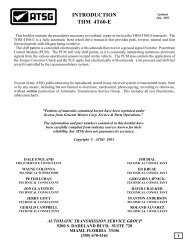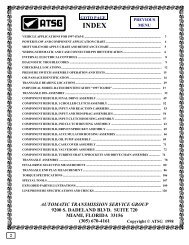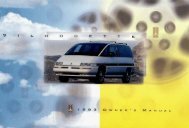Controls
Controls
Controls
Create successful ePaper yourself
Turn your PDF publications into a flip-book with our unique Google optimized e-Paper software.
~ space<br />
’ 0 Since you can’t see as well, you may<br />
need to slow down and keep more<br />
between you and other vehicles.<br />
l<br />
0 Slow down, especially on higher<br />
speed roads. Your headlights can light<br />
up only so much road ahead.<br />
0 In remote areas, watch for animals.<br />
a If you’re tired, pull off the road in a<br />
safe place and rest.<br />
Night Vision<br />
No one can see as well at night as in the<br />
daytime. But as we get older these<br />
differences increase. A 50-year-old driver<br />
may require at least twice as much light to<br />
see the same thing at night as a<br />
20-year-old.<br />
What you do in the daytime can also<br />
affect your night vision. For example, if<br />
you spend the day in bright sunshine you<br />
are wise to wear sunglasses. Your eyes<br />
will have less trouble adjusting to night.<br />
But if you’re driving, don’t wear<br />
sunglasses at night. They may cut down<br />
on glare from headlights, but they also<br />
make a lot of things invisible.<br />
You can be temporarily blinded by<br />
approaching lights. It can take a second or<br />
two, or even several seconds, for your<br />
eyes to readjust to the dark. When you are<br />
faced with severe glare (as from a driver<br />
who doesn’t lower the high beams, or a<br />
vehicle with misaimed headlights), slow<br />
down a little. Avoid staring directly into<br />
the approaching lights.<br />
Keep your windshield and all the glass on<br />
your vehicle clean -- inside and out.<br />
Glare at night is made much worse by dirt<br />
on the glass. Even the inside of the glass<br />
can build up a film caused by dust. Dirty<br />
glass makes lights dazzle and flash more<br />
than clean glass would, making the pupils<br />
of your eyes contract repeatedly.<br />
Remember that your headlights light up<br />
far less of a roadway when you are in a<br />
turn or curve. Keep your eyes moving;<br />
that way, it’s easier to pick out dimly<br />
lighted objects. Just as your headlights<br />
should be checked regularly for proper<br />
aim, so should your eyes be examined<br />
regularly. Some drivers suffer from night<br />
blindness -- the inability to see in dim<br />
light -- and aren’t even aware of it.<br />
Driving in the Rain;<br />
Rain and wet roads can mean drivfng<br />
trouble. On a wet road you can’t stop,<br />
accelerate or turn as well because your<br />
tire-to-road traction isn’t as good as on<br />
dry roads. And, if your tires don’t ‘have<br />
much tread left, you’ll get even less<br />
traction. It’s always wise to go slower and<br />
be cautious if rain starts to fall while you<br />
are driving. The surface may get wet<br />
suddenly when your reflexes are tuned for<br />
driving on dry pavement.<br />
159 ...








